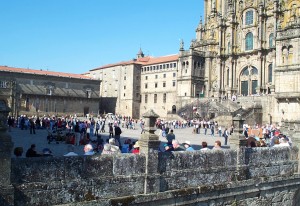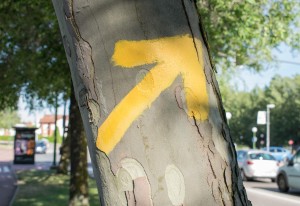A Well-Marked Historical Route
The Camino de Santiago, with its multiple routes crossing Europe to converge in Santiago de Compostela, is known not only for its historical and cultural richness but also for its excellent signage. This feature is essential for pilgrims, ensuring a safe and hassle-free journey. Below, we explore the various signage elements you will find on the Camino de Santiago and how they will help you reach your destination.
The Yellow Arrows: The Symbol of the Camino
The most iconic signage element on the Camino de Santiago is undoubtedly the yellow arrow. Painted on walls, posts, rocks, and pavements, these arrows indicate the correct direction and are visible at all times. The yellow arrow was introduced in the 1980s by parish priest Elías Valiña, who sought a simple and effective way to guide pilgrims. Its simplicity and ubiquity have made it the quintessential symbol of the Camino.
Mile Markers and Milestones
Along the route, especially on the more official paths like the French Way, you will find stone mile markers or milestones indicating the remaining distance to Santiago de Compostela. These markers often feature the scallop shell, another important symbol of the Camino, and are placed at regular intervals. In Galicia, for example, it is common to see these markers every kilometer, providing pilgrims with a clear reference of their progress.
The Scallop Shell: A Millenary Symbol
The scallop shell is a symbol historically associated with the Camino de Santiago and is found in various forms along the route. In signage, the shell usually appears on ceramic, metal, or stone plaques, indicating the way forward. The position of the lines on the shell can vary, but they all converge at one point, symbolizing the different routes leading to Santiago. The scallop shell also serves as a reminder of the spiritual and physical goal of the pilgrimage.
Vertical Signs and Informative Panels
In addition to arrows and mile markers, you will find vertical signs and informative panels at strategic points along the way. These signs, similar to those used in hiking trails, provide useful information such as directions, distance to the next town or hostel, and warnings about difficult terrain. Informative panels usually include maps and descriptions of the stages, points of interest, and available services, such as restaurants and health centers.
Pavement Marks and Symbols
In urban areas, signage can include marks and symbols on the pavement. These signs, generally in the form of painted shells or yellow arrows, help pilgrims navigate cities and towns where streets can be more confusing. It is important to pay attention to these marks, especially at intersections and detours.
Technology and Digital Signage
With the advancement of technology, many pilgrims also use mobile applications and GPS devices to complement traditional signage. Numerous apps provide detailed maps, locations of hostels, and emergency services. While technology can be a great help, it is advisable not to rely solely on it and always pay attention to the physical signs on the Camino.
Maintenance and Updating of Signage
The signage of the Camino de Santiago is maintained and regularly updated thanks to the collaboration of Camino friends’ associations, local governments, and volunteers. This community effort ensures that the signs are in good condition and visible, even after adverse weather conditions. Pilgrims can also contribute to this effort by reporting damaged or missing signs to local authorities.
Respecting the Signage
It is essential for all pilgrims to respect the signage and use it correctly. Not altering, covering, or removing the signs is fundamental to maintaining the integrity of the Camino and ensuring the safety of all walkers. Additionally, following the official signs helps preserve the authenticity and spirit of the Camino de Santiago.
A Safe Guide to Santiago
Signage on the Camino de Santiago is a crucial part of the pilgrim’s experience. The yellow arrows, mile markers, scallop shells, and vertical signs work together to guide walkers along their spiritual and physical journey. This network of signs not only provides direction and safety but also connects pilgrims with the rich history and traditions of the Camino. Thanks to well-maintained signage, pilgrims can focus on the beauty of the journey and their own introspection, confident that they are on the right path to Santiago de Compostela. ¡Buen Camino!












